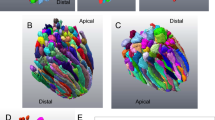Summary
The effect of illumination on the degradation of microvillar membrane in the invertebrate photoreceptor cell has been correlated with the appearance in the cytoplasm of certain distinct lysosome-related bodies. Three types of organelles were distinguished in the retinula cell cytoplasm of the crayfish, multivesicular bodies (MVB), both large (4.20-1.50 μm) and small (1.49-0.30 μm), combination bodies (CB), and lamellar bodies (LB). Under diurnal lighting conditions significant temporal differences were found in the appearance of these three classes of organelles in the retinula cell. Small MVB are present at a consistent level throughout most of the diurnal cycle but show peak numbers at 30 min after light onset and again after 6 h of dark adaptation. Large MVB increase significantly 1 h after light onset and remain elevated through 4 h in the light. After 4 h the large MVB decline gradually for the remaining light period. Combination bodies and LB do not begin to increase until 1 h after light onset and are at peak levels between 4 and 6 h into the light period. The minimum rhabdome diameter coincides with the peak levels of large MVB, CB, and LB. These data support the hypothesis that light causes microvillar membrane breakdown, resulting in the initial production of MVB which in turn undergo degradation to form CB and finally LB. This primary degradative response appears to be completed within the first 8 h of the light period.
Similar content being viewed by others
References
Bähr R (1972) Licht- und dunkeladaptive Änderungen der Sehzellen von Lithobius forficatus L. (Chilopoda: Lithobiidae). Cytobiologie 6:214–233
Barlow RB Jr, Bolanowski SJ, Brachman ML (1977) Efferent optic nerve fibers mediate circadian rhythms in the Limulus eye. Science 197:86–89
Basinger S, Hoffman R, Matthes M (1976) Photoreceptor shedding is initiated by light in the frog retina. Science 194:1074–1076
Behrens M, Krebs W (1976) The effect of light and dark adaptation on the ultrastructure of Limulus lateral eye retinular cells. J Comp Physiol 107:79–96
Bennitt R (1932) Diurnal rhythm in proximal pigment cells of the crayfish retina. Physiol Zool 5:49–64
Blest AD (1978) The rapid synthesis and destruction of photoreceptor membrane by a dinopid spider: a daily cycle. Proc Soc Lond B 200:463–483
Blest AD, Day WA (1978) The rhabdomere organization of some nocturnal pisaurid spiders in light and darkness. Phil Trans Soc Lond B 283:1–23
Blest AD, Kao L, Powell K (1978) Photoreceptor membrane breakdown in the spider Dinopis: The fate of rhabdomere products. Cell Tissue Res 195:425–444
Blest AD, Powell K, Kao L (1978) Photoreceptor membrane breakdown in the spider Dinopis: GERL differentiation in the receptors. Cell Tissue Res 195:277–297
Brammer JD, Clarin B (1976) Changes in volume of the rhabdom in the compound eye of Aedes aegypti L. J Exp Zool 195:33–40
Brammer JD, Stein PJ, Anderson RA (1978) Effect of light and dark adaptation upon the rhabdom in the compound eye of the mosquito. J Exp Zool 206:151–156
Chamberlain SC, Barlow RB Jr (1978) Morphologic correlates of circadian sensitivity changes and rhabdom renewal in the Limulus lateral eye. Supplement to Investigative Ophthalmology and Visual Science. ARVO abstract p 134
Chamberlain SC, Barlow RB Jr (1979) Light and efferent activity control rhabdom turnover in Limulus photorecptors. Science 206:361–363
Eguchi E, Waterman TH (1967) Changes in retinal fine structure induced in the crab Libinia by light and dark adaptation. Z Zellforsch 79:209–229
Eguchi E, Waterman TH (1976) Freeze-etch and histochemical evidence for cycling in crayfish photoreceptor membranes. Cell Tissue Res 169:419–434
Eguchi E, Waterman TH, Akiyama J (1973) Localization of the violet and yellow receptor cells in the crayfish retinula. J Gen Physiol 62:355–374
Hollyfield JG, Besharse JC, Rayborn ME (1976) The effect of light on the quantity of phagosomes in the pigment epithelium. Exp Eye Res 23:623–635
Itaya SK (1976) Rhabdom changes in the shrimp Palaemonetes. Cell Tissue Res 166:265–273
Karnovsky MJ (1965) A formaldehyde-glutaraldehyde fixative of high osmolarity for use in electron microscopy. J Cell Biol 27:137A-138A
LaVail MM (1976) Rod outer segment disc shedding in rat; relationship to cyclic lighting. Science 194:1071–1073
Nässel RR, Waterman TH (1979) Massive diurnally modulated photoreceptor membrane turnover in crab light and dark adaptation. J Comp Physiol 131:205–216
O'Day WT, Young RW (1978) Rhythmic daily shedding of outer segment membranes by visual cells in the goldfish. J Cell Biol 76:593–604
Page TL, Larimer JL (1975) Neural control of circadian rhythmicity in the crayfish II. The ERG amplitude rhythm. J Comp Physiol 97:81–96
Remé CE, Sulser M (1977) Diurnal variations of autophagy in rod visual cells in the rat. Graefes Arch Klin Exp Ophthal 203:261–270
Weibel ER (1973) Stereological techniques for electron microscopic morphometry. In: Hayat MA (ed) Principles and techniques of electron microscopy, Vol. 3. Van Nostrand Rheinhold, New York Cincinnati Toronto London Melbourne, pp 237–288
Welsh JH (1941) The sinus glands and 24-h cycles of retinal pigment migration in the crayfish. J Exp Zool 86:35–49
White RH (1968) The effect of light and dark deprivation upon the ultrastructure of the larval mosquito eye. III. Multivesicular bodies and protein uptake. J Exp Zool 169:261–278
White RH, Lord E (1975) Diminution and enlargement of the mosquito rhabdom in light and darkness. J Gen Physiol 65:583–598
Williams MA (1977) Quantitative methods in biology. In: Glauert AM (ed) Practical methods in electron microscopy, Vol 6, Chap 1. North-Holland Publishing Co, Amsterdam New York Oxford
Author information
Authors and Affiliations
Additional information
Supported by a grant from the National Science Foundation (BNS77-15803) and PHS Grant S05-RR-7031
Rights and permissions
About this article
Cite this article
Hafner, G.S., Hammond-Soltis, G. & Tokarski, T. Diurnal changes of lysosome-related bodies in the crayfish photoreceptor cells. Cell Tissue Res. 206, 319–332 (1980). https://doi.org/10.1007/BF00232775
Accepted:
Issue Date:
DOI: https://doi.org/10.1007/BF00232775




